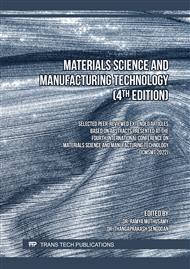[1]
B. N. Mordyuk, G. I. Prokopenko, M. A. Vasylyev, and M. O. Iefimov, Effect of structure evolution induced by ultrasonic peening on the corrosion behavior of AISI-321 stainless steel,, Materials Science and Engineering: A, vol. 458, no. 1–2, p.253–261, Jun. 2007,.
DOI: 10.1016/j.msea.2006.12.049
Google Scholar
[2]
M. S. Ghazani and B. Eghbali, Characterization of the hot deformation microstructure of AISI 321 austenitic stainless steel,, Materials Science and Engineering: A, vol. 730, p.380–390, Jul. 2018,.
DOI: 10.1016/j.msea.2018.06.025
Google Scholar
[3]
H. Li et al., Microstructure evolution and mechanical properties of friction stir welding super-austenitic stainless steel S32654,, Materials & Design, vol. C, no. 118, p.207–217, Mar. 2017,.
DOI: 10.1016/j.matdes.2017.01.034
Google Scholar
[4]
S. Pour-Ali, M. Weiser, N. Truong Nguyen, A.-R. Kiani-Rashid, A. Babakhani, and S. Virtanen, High temperature oxidation behaviour of AISI 321 stainless steel with an ultrafine-grained surface at 800 °C in Ar–20 vol.% O2,, Corrosion Science, vol. 163, p.108282, Feb. 2020,.
DOI: 10.1016/j.corsci.2019.108282
Google Scholar
[5]
K. V. Shankar, R. Sellamuthu, Determination on the effect of tin content on microstructure, hardness, optimum aging temperature and aging time for spinodal bronze alloys cast in metal mold,, International Journal of Metalcasting, 11(2):189-194, 2017.
DOI: 10.1007/s40962-016-0034-6
Google Scholar
[6]
A. Calik, F. Taylan, O. Sahin, N. Ucar, Comparison of mechanical properties of boronized and vanadium carbide coated AISI 1040 steels,, Indian Journal of Engineering and Materials Sciences, 16(5):326-330 (2009).
DOI: 10.12693/aphyspola.115.694
Google Scholar
[7]
A. P. Gopkalo and A. V. Rutkovskyy, The effect of PVD coatings on the tensile strength and low-cycle fatigue resistance of stainless steel and titanium alloys,, Fatigue & Fracture of Engineering Materials & Structures, vol. 34, no. 12, p.1012–1020, Dec. 2011,.
DOI: 10.1111/j.1460-2695.2011.01590.x
Google Scholar
[8]
B. S. Saini and V. K. Gupta, Effect of WC/C PVD coating on fatigue behaviour of case carburized SAE8620 steel,, Surface and Coatings Technology, vol. 205, no. 2, p.511–518, Oct. 2010,.
DOI: 10.1016/j.surfcoat.2010.07.022
Google Scholar
[9]
S.V. Sajadifar, H.J. Maier, T. Niendorf, G. G. Yapici, Fracture behavior of ultrafine-grained titanium under tension at elevated temperatures,, Journal of Engineering Materials and Technology, vol. 143, no. 4, Oct. 2020,.
DOI: 10.1115/1.4047747
Google Scholar
[10]
S.V. Sajadifar, G. G. Yapici, High temperature flow response modeling of ultra-fine grained titanium,, Metals, vol. 5, pp.1315-1327, 2015,.
DOI: 10.3390/met5031315
Google Scholar
[11]
A. Hosseinzadeh and G. G. Yapici, On the High-Temperature Flow Response of Friction Stir Processed Magnesium Metal Matrix Composites,, Journal of Engineering Materials and Technology, vol. 143, no. 1, Jan. 2021,.
DOI: 10.1115/1.4047966
Google Scholar
[12]
H. Bai et al., A review on wear-resistant coating with high hardness and high toughness on the surface of titanium alloy,, Journal of Alloys and Compounds, vol. 882, p.160645, Nov. 2021,.
DOI: 10.1016/j.jallcom.2021.160645
Google Scholar
[13]
A. Hosseinzadeh and G. G. Yapici, High temperature characteristics of Al2024/SiC metal matrix composite fabricated by friction stir processing,, Materials Science and Engineering: A, vol. 731, p.487–494, Jul. 2018,.
DOI: 10.1016/j.msea.2018.06.077
Google Scholar
[14]
U. Sen and S. Sen, The fracture toughness of borides formed on boronized cold work tool steels,, Materials Characterization, vol. 50, no. 4–5, p.261–267, Jun. 2003,.
DOI: 10.1016/s1044-5803(03)00104-9
Google Scholar
[15]
J.-S. Xu, X.-C. Zhang, F.-Z. Xuan, F.-Q. Tian, Z.-D. Wang, and S.-T. Tu, Tensile properties and fracture behavior of laser cladded WC/Ni composite coatings with different contents of WC particle studied by in-situ tensile testing,, Materials Science and Engineering: A, vol. 560, p.744–751, Jan. 2013,.
DOI: 10.1016/j.msea.2012.10.028
Google Scholar



